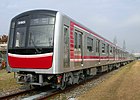Osaka Municipal Subway 70 series
| Osaka Municipal Subway 70 series | |
|---|---|
 Osaka Municipal Subway 70 series in revised livery at Kadoma-minami Station, March 2012 | |
| In service | 1990–present |
| Manufacturer | Kawasaki Heavy Industries, Kinki Sharyo, Nippon Sharyo, Alna Kōki |
| Constructed | 1990–1997 |
| Entered service | 20 March 1990 |
| Refurbished | 2011– |
| Number built | 100 cars (25 sets) |
| Number in service | 100 cars |
| Formation | 4 cars per trainset |
| Capacity | 380 |
| Operators | Osaka Municipal Transportation Bureau (1990–2018) |
| Depots | Tsurumi |
| Lines served | |
| Specifications | |
| Car body construction | Aluminium |
| Train length | 62.8 m (206 ft 0 in) |
| Car length | 15.8 m (51 ft 10 in) (end cars) 15.6 m (51 ft 2 in) (intermediate cars) |
| Doors | 3 pairs of sliding doors per side |
| Maximum speed | 70 km/h (43 mph) |
| Weight | 102 t (100 long tons; 112 short tons) |
| Traction system | Variable-frequency |
| Traction motors | Linear motors |
| Power output | 800 kW (1,073 hp) |
| Acceleration | 2.5 km/(h⋅s) (1.6 mph/s) |
| Deceleration | 3.5 km/(h⋅s) (2.2 mph/s) (service) 4.5 km/(h⋅s) (2.8 mph/s) (emergency) |
| Electric system(s) | 1,500 V DC |
| Current collector(s) | Pantograph |
| Braking system(s) | Electric commanding |
| Safety system(s) | CS-ATC, ATO |
| Track gauge | 1,435 mm (4 ft 8+1⁄2 in) |
The Osaka Municipal Subway 70 series (大阪市交通局70系) is a rapid transit electric multiple unit (EMU) train type operated by Osaka Municipal Subway on the Nagahori Tsurumi-ryokuchi Line in Japan.[1]
The 70 series was among the earliest trains in Japan to use linear motors, and is capable of driverless operation.
Refurbishment
All 25 70 series trains are scheduled to undergo major refurbishment, with set 13 the first refurbished set to re-enter service on March 4, 2011.[citation needed] The refurbishment will include the fitting of new linear motor traction systems, a new 3-colour LED display system above passenger doors, new LCD passenger information monitors, lower hand grips, a yellow line printed on passenger doors and new train car number indicators on the exterior similar to those seen on the 30000 series and the refurbished 25 series trains.
